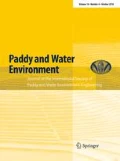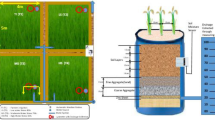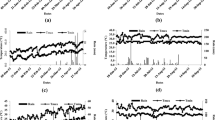Abstract
Rice is the main crop produced in the Senegal River Valley under the semiarid Sahelian climate where water resource management is critical for the resource use sustainability. However, very limited data exit on rice water use and irrigation water requirement in this water scarcity environment under climate change conditions. Understanding crop water requirements is essential for better irrigation practices, scheduling and efficient use of water. The objectives of this study were to estimate crop water use and irrigation water requirement of rice in the Senegal River Valley at Fanaye. Field experiments were conducted during the 2013 hot and dry season and wet season, and 2014 hot and dry season and wet seasons. Three nitrogen fertilizer treatments were applied to rice variety Sahel 108: 60, 120, and 180 kg N ha−1. Rice water use was estimated by the two-step approach. Results indicated that crop actual evapotranspiration (ETa) varied from 632 to 929 mm with the highest ETa obtained during the hot and dry seasons. Irrigation water requirement varied from 863 to 1198 mm per season. Rice grain yield was function of the growing season and varied from 4.1 to 10.7 tons ha−1 and increased with nitrogen fertilizer rate. Rice water use efficiency relative to ETa and irrigation requirements increased with nitrogen fertilizer rate while rice nitrogen use efficiency decreased with the nitrogen fertilizer rates. The results of this study can be used as a guideline for rice water use and irrigation water requirement for the irrigation design projects, consultants, universities, producers, and other operators within rice value chain in the Senegal River Valley.







Similar content being viewed by others
References
Aguilar M, Borjas F (2005) Water use in three rice flooding management systems under Mediterranean climatic conditions. Span J Agric Res 3(3):344–351
Alberto MCR, Wassmann R, Hirano T, Miyata A, Hatano R, Kumar A, Padre A, Amante A (2011) Comparisons of energy balance and evapotranspiration between flooded and aerobic rice fields in the Philippines. Agric Water Manage 98(9):1417–1430
Allen RG, Pereira LS, Raes D, Smith M (1998) Crop evapotranspiration: guidelines for computing crop water requirements. FAO irrigation and drainage Paper No. 56. FAO, Rome
Arnold JG, Srinivasan R, Muttiah RS, Williams JR (1998) Large-area hydrologic modeling and assessment: Part I. Model development. J Am Water Resour Assoc 34(1):73–89
ASCE-EWRI (2005) The ASCE standardized reference evapotranspiration equation. In: Allen RG, Walter IA, Elliot RL et al (eds) Environmental and Water Resources Institute (EWRI) of the American Society of Civil Engineers, ASCE, Standardization of reference evapotranspiration task committee final report. American Society of Civil Engineers (ASCE), Reston
Bagadion B, Gambon R, Abesamis L, Lazaro RC (1978) The water management training program of the upper Pampanga River Project. National Irrigation Administration, Philippines. In: Irrigation policy and management in Southeast Asia, International Rice Research Institute, Los Baños. pp 103–110
Bos MG (1980) Irrigation efficiencies at crop production level. ICID Bull 29(2):18–25, 60
Bos MG (1985) Summary of ICID definitions of irrigation efficiency. ICID Bull 34(1):28–31
Bouman BAM, Peng S, Castan˜eda AR, Visperas RM (2005) Yield and water use of irrigated tropical aerobic rice systems. Agric Water Manag 74(2005):87–105
Bouraima AK, Weihua Z, Chaofu W (2015) Irrigation water requirements of rice using Cropwat model in Northern Benin. Int J Agric Biol Eng 8(2):58–64. doi:10.3965/j.ijabe.20150802.1290
Cabangona RJ, Tuong TP, Abdullah NB (2002) Comparing water input and water productivity of transplanted and direct-seeded rice production systems. Agric Water Manag 57:11–31
Cassman KG, Gines GC, Dizon MA, Samson MI, Alcantara JM (1996) Nitrogen-use efficiency in tropical lowland rice systems: contributions from indigenous and applied nitrogen. Field Crops Res 47:1–12
Chahal GBS, Sood A, Jalota SK, Choudhury BU, Sharma PK (2007) Yield, evapotranspiration and water productivity of rice (Oryza sativa L.) and wheat (Triticum aestivum L.) system in Punjab (India) as influenced by transplanting date of rice and weather parameters. Agric Water Manag 88:14–22
Comas J, Connor D, El Moctar Isselmou M, Mateos L, Gómez-Macpherson H (2012) Why has small-scale irrigation not responded to expectations with traditional subsistence farmers along the Senegal River in Mauritania? Agric Syst 110:152–161
Cristea NC, Kampf SK, Burges SJ (2013) Linear models for estimating annual and growing season reference evapotranspiration using averages of weather variables. Int J Climatol 33:376–387
DeDatta SK (1981) Principles and practices of rice production. John Wiley, New York
De Vries ME, Rodenburg J, Bado BV, Sow A, Leffelaar PA, Giller KE (2010) Rice production with less irrigation water is possible in a Sahelian environment. Field Crops Res 116:154–164
Diop NF, Malou R, Da Costa H, Mendy A (2002) Contrainte climatique des nappes d’eau souterraines en zones soudano-sahéliennes: Cas de la nappe phréatique du bassin de la Néma dans la région du Sine au centre-ouest du Sénégal. Afr J Sci Technol Sci Eng 3(1):44–50
Djaman K, Irmak I (2012) Soil water extraction patterns, crop-, irrigation-, and evapotranspiration water use efficiency under full and limited irrigation and rainfed conditions. Trans ASABE 55(4):1223–1238
Djaman K, Irmak S (2013) Actual crop evapotranspiration and alfalfa- and grass-reference crop coefficients of maize under full and limited irrigation and rainfed conditions. J Irrig Drain Eng 139:433–446
Djaman K, Irmak S, Martin DL, Ferguson RB, Bernards ML (2013) Plant nutrient (N, P, K) uptake, grain nutrient content, and soil nutrient dynamics under full and limited irrigation and rainfed maize production. Agron J 105:527–538. doi:10.2134/agronj2012.0269
Djaman K, Balde AB, Sow A, Muller B, Irmak S, N’Diaye MK, Manneh B, Moukoumbi YD, Futakuch K, Saito K (2015) Evaluation of sixteen reference evapotranspiration methods under Sahelian conditions in the Senegal River Valley. J Hydrol Reg Stud 3:139–159. doi:10.1016/j.ejrh.2015.02.002
Doorenbos J, Pruitt WO (1977) Guidelines for predicting crop water requirements. FAO irrigation and drainage, Paper No. 24. FAO, Rome
DPCSE (2009) Enquête auprès des Ménages et Exploitants Agricoles. Résultats définitifs de la campagne agricole 2008/2009. Direction des Politiques, de la Coopération et du Suivi Evaluation, Ministère Développement Rural, Nouakchott
Ebaid RA, El-Refaee IS (2007) Utilization of rice husk as an organic fertilizer to improve productivity and water use efficiency in rice fields. Afr Crop Sci Conf Proc 8:1923–1928
Fukai S, Sittisuang P, Chanphengsay M (1998) Increasing production of rainfed lowland rice in drought prone enviroments: a case study in Thailand and Laos. Plant Prod Sci 1:75–82
García-Bolaños M, Borgia C, Poblador N, Dia M, Seyid OMV, Mateos L (2011) Performance assessment of small irrigation schemes along the Mauritanian banks of the Senegal River. Agric Water Manag 98:1141–1152
Grassi C, Bouman BAM, Castañeda AR, Manzelli M, Vecchio V (2009) Aerobic rice: crop performance and water use efficiency. J Agric Environ Int Dev 103(4):259–270
Haefele SM (2001) Improved and sustainable nutrient management for irrigated rice-based cropping systems in West Africa. Hamburger bodenkundliche arbeiten. Universitat Hamburg, Hamburg
Haefele SM, Johnson DE, Diallo S, Wopereis MCS, Janin I (2000) Improved soil fertility and weed management is profitable for irrigated rice farmers in Sahelian West Africa. Field Crops Res 66:101–113
Haefele SM, Wopereis MCS, Donovan C, Maubuisson J (2001) Improving the productivity and profitability of irrigated rice production in Mauritania. Eur J Agron 14:181–196
Haefele SM, Wopereis MCS, Schloebohm A, Wiechmann H (2004) Long-term fertility experiments for irrigated rice in the West African Sahel: effect on soil characteristics. Field Crops Res 85:61–77
Hargreaves GL, Hargreaves GH, Riley JP (1986) Irrigation water requirements for Senegal River Basin. J Irrig Drain Eng 1(3):265–275
Hatfield JL, Sauer TJ, Prueger JH (2001) Managing soils to achieve greater water use efficiency: a review. Agron J 93(2):271–280
Hendrickx JMH, Wierenga PJ, Nash MS, Nielsen DR (1986) Boundary location from texture, soil moisture, and infiltration data. Soil Sci Soc Am J 50:1515–1520
Howell TA (2001) Enhancing water use efficiency in irrigated agriculture. Agron J 93(2):281–289
Irmak S, Mutiibwa D (2010) On the dynamics of canopy resistance: generalized-linear estimation and relationships with primary micrometeorological variables. Water Resour Res 46(1–20):W08526. doi:10.1029/2009WR008484
Irmak S, Irmak A, Howell TA, Martin DL, Payero JO (2008) Copeland Variability analyses of alfalfa-reference to grass-reference evapotranspiration ratios in growing and dormant seasons. J Irrig Drain Eng ASCE 134(2):147–159. doi:10.1061/(ASCE)0733-9437
Irmak S, Odhiambo LO, Eisenhauer DE (2011) Irrigation efficiency and uniformity, and crop water use efficiency. Extension Bulletin EC732. University of Nebraska-Lincoln, Lincoln
Jensen ME (1968) Water consumption by agricultural plants. In: Kozlowski TT (ed) Water deficits and plant growth, vol 2. Academic, New York, pp 1–45
Jensen ME, Burman RD, Allen RG (1990) Evapotranspiration and Irrigation Water Requirements. ASCE Manuals and Reports on Engineering Practice No. 70, Am. Soc. Civil Engr., New York, NY. 332 pp
Jones JW, Dockings JO, Walker RK, Davis WC (1952) Rice production in the Southern States, US. Dep. Agr. Farmers’ Bull. 2043
Kaushal KG, Bhabani SD, Mohammad S, Pratap BS (2009) Measurement and modelling of soil water regime in a lowland paddy field showing preferential transport. Agric Water Manag 96:1705–1714
Kebbeh M, Miézan KM (2003) Ex-ante evaluation of integrated crop management options for irrigated rice production in the Senegal River Valley. Fld Crops Res 81:87–94
Krupnik TJ, Rodenburg J, Haden VR, Mbaye D, Shennan C (2012) Genotypic trade-offs between water productivity and weed competition under the System of Rice Intensification in the Sahel. Agric Water Manag 115:156–166
Kuo S, Ho S, Liu C (2006) Estimation irrigation water requirements with derived crop coefficients for upland and paddy crops in China Irrigation Association, Taiwan. Agric Water Manag 82:433–445
Lage M, Bamouh A, Karrou M, El Mourid M (2003) Estimation of rice evapotranspiration using microlysimeter technique and comparison with FAO Penman-Monteith and Pan evaporation methods under Moroccan condition. Agronomie 23:625–631
Lettenmaier DL, Wood EF (1992) Hydrologic forecasting. In: Maidment DR (ed) Handbook of hydrology (Chapter 26). McGraw-Hill Inc., New York, pp 1–3
Mbodj S (2008). Une meilleure valorisation des ressources des bas-fonds du Sine Saloum par la gire: expérience du programme de lutte contre la pauvreté en milieu rural dans le Bassin Arachidier.PRODDEL Rapp. Technol. p 88
Monteith JL (1965) Evaporation and environment. Symp Soc Exp Biol 19:205–224
Moratiel R, Martınez-Cob A (2013) Evapoytranspiration and crop coefficient of rice (Oriza sativa L.) under sprinkler irrigation in a semi-arid climate determined by the surface renewal method. Irrig Sci 31:411–422
Mutiibwa D, Irmak S (2011) On the scaling up soybean leaf level stomatal resistance to canopy resistance for one-step estimation of actual evapotranspiration. Trans ASABE 54(1):141–154
Nielsen R (2006) N loss mechanism and nitrogen use efficiency, Purdue Nitrogen Management Workshops. Purdue University, West Lafayette
OMVS-SOGREAH (1998) Etude complementaire des endiguements du fleuve Sénégal Premiere phase Rapport d’inventaire-diagnostrc. OMVS, Dakar
Peng S, Buresh RJ, Huang J, Zhong X, Zou Y (2010) Improving nitrogen fertilization in rice by site-specific N management. A review. Agron Sustain Dev 30(3):650–656
Pereira Luis S, Allen RG, Smith M, Raes D (2015) Crop evapotranspiration estimation with FAO56: past and future. Agric Water Manag 147:4–20
Poussin JC, Wopereis MCS, Debouzie D, Maeght JL (2003) Determinants of irrigated rice yield in the Senegal River Valley. Eur J Agron 19:341–356
Poussin JC, Diallo Y, Legoupil JC, Sow A (2005) Increase in rice productivity in the Senegal River Valley due to improved collective management of irrigation schemes. Agron Sustain Dev 25(2):225–236
Poussin JC, Diallo Y, Legoupil JC (2006) Improved collective decision-making in action for irrigated rice farmers in the Senegal River Valley. Agric Syst 89:299–323
Pradhan S, Chopra UK, Bandyopadhyay KK, Singh R, Jain AK, Chand I (2013) Effect of water and nitrogen management on water productivity and nitrogen use efficiency of wheat in a semi-arid environment. Int J Agric Food Sci Technol 4(7):727–732
Raes D, Sy B, Van Passel L (1992) The water balance of rice irrigation schemes in the Senegal River Delta. In: Feyen J, Mwendera E, Badji M (eds) Advances in planning design and management of irrigation systems as related to sustainable land use, vol 2. Proceedings of an international conference, Leuven, pp 835–844
Raes D, Sy B, Feyen J (1994) Water use in rice schemes in the Senegal River Delta and Valley. Irrig Drain Syst 9(117):128. doi:10.1007/BF00881671
Raes D, Deckers J, Diallo AM (1995) Water requirements for salt control in rice schemes in the Senegal River Delta and Valley. Irrig Drain Syst 9(1995):129–141. doi:10.1007/BF00881672
Rijsberman FR (2006) Water scarcity: fact or fiction? Agric Water Manag 80:5–22
Saito K, Futakuchi K (2009) Performance of diverse upland rice cultivars in low and high fertility conditions in West Africa. Field Crop Res 111:243–250
Samba Diene R (1998) Riziculture et dégradation des sols en vallée du fleuve Sénégal: analyse comparée des fonctionnements hydro-salins des sols du delta et de la moyenne vallée en simple et double riziculture. Thèse de Doctorat, Université Cheikh Anta Diop, Dakar
Segda Z, Haefele SM, Wopereis MCS, Sedogo MP, Guinko S (2004) Agro-economic characterization of rice production in a typical irrigation scheme in Burkina Faso. Agronomy Journal 96(5):1314–1322. doi:10.2134/agronj2004.1314
Snyder RL, Lanini BJ, Shaw DA, Pruitt WO (1987) Using reference evapotranspiration (ETo) and crop coefficients to estimate crop evapotranspiration (ETc) for trees and vines. Univ. Calif. Div. Agric. Natural Resources, Leaflet No. 21428
Spanu A, Murtas A, Ballone F (2009) Water use and crop coefficients in sprinkler irrigated rice. Ital J Agron 2:47–58
Tabbal DF, Bouman BAM, Bhuiyan SI, Sibayan EB, Sattar MA (2002) On-farm strategies for reducing water input in irrigated rice: case studies in the Philippines. Agric Water Manag 56(2):93–112
Tanaka A, Diagne M, Kazuki S (2015) Causes of yield stagnation in irrigated lowland rice systems in the Senegal River Valley: application of dichotomous decision tree analysis. Field Crop Res 176:99–107
Traoré K, Bado BV, Guèye T, Gaye S (2010) Grain yield performance of interspecific irrigated rice genotypes in the Senegal River Valley, as affected by the cropping seasons. West Afr J Appl Ecol 17:65–80
Tuong TP (1999) Productive water use in rice production: opportunities and limitations. J Crop Prod 2(2):241–264
Tyagi NK, Sharma DK, Luthra SK (2000) Determination of evapotranspiration and crop coefficient of rice and sunflower with lysimeter. J Agric Water Manag 45:41–64
Vu SH, Watanabe H, Takagi K (2005) Application of FAO-56 for evaluating evapotranspiration in simulation of pollutant runoff from paddy rice field in Japan. Agric Water Manag 76:195–210
WARDA (2004) The Africa Rice Center—recognizing WARDA’s role in sub-Saharan Africa. In: WARDA Annual Report 2002–2003. WARDA—The Africa Rice Center, Bouaké, pp 7–12
Wopereis MCS, Ceuppens J, Boivin P, Ndiaye AM, Kane A (1998) Preserving soil quality under irrigation in the Senegal River Valley. Neth J Agric Sci 46:97–107
Wopereis MCS, Donovan C, Nebié B, Guindo D, N’Diaye DMK (1999) Soil fertility management in irrigated rice systems in the Sahel and Savanna regions of West Africa: Part I. Agronomic analysis. Field Crops Res 61:125–145
Yang W, Peng S, Rebecca C, Laza RC, Visperas RM, Dionisio-Sese ML (2008) Yield gap analysis between dry and wet season rice crop grown under high-yielding management conditions. Agron J 100(5):1390–1395
Ye Q, Yang X, Dai S, Chen G, Li Y, Zhang C (2015) Effects of climate change on suitable rice cropping areas, cropping systems and crop water requirements in southern China. Agric Water Manag 159:35–44
Zhang Y, Tang Q, Peng S, Xing D, Qin J, Laza RC, Punzalan BR (2012) Water use efficiency and physiological response of rice cultivars under alternate wetting and drying conditions. Sci World J 2012(287907):10. doi:10.1100/2012/287907
Zhao L, Wu L, Dong C, Li Y (2010) Rice yield, nitrogen utilization and ammonia volatilization as influenced by modified rice cultivation at varying nitrogen rates. Agric Sci 1(1):10–16. doi:10.4236/as.2010.11002
Zwart SJ (2013) Assessing and improving water productivity of irrigated rice systems in Africa. CAB International 2013. Wopereis MCS et al. (eds) Realizing Africa’s rice promise
Zwart SJ, Bastiaanssen WGM (2004) Review of measured crop water productivity values for irrigated wheat, rice, cotton and maize. Agric Water Manag 69:115–133
Author information
Authors and Affiliations
Corresponding author
Rights and permissions
About this article
Cite this article
Djaman, K., Mel, V.C., Balde, A.B. et al. Evapotranspiration, irrigation water requirement, and water productivity of rice (Oryza sativa L.) in the Sahelian environment. Paddy Water Environ 15, 469–482 (2017). https://doi.org/10.1007/s10333-016-0564-9
Received:
Revised:
Accepted:
Published:
Issue Date:
DOI: https://doi.org/10.1007/s10333-016-0564-9




